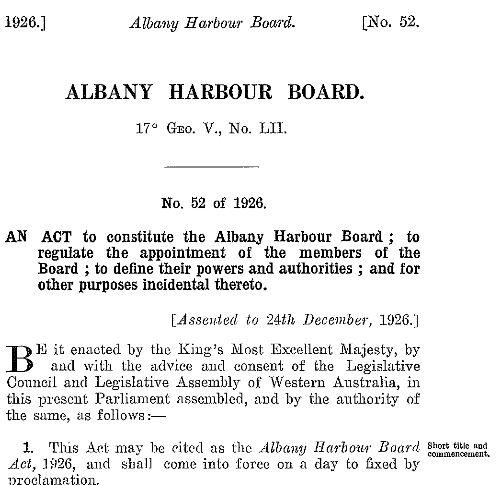Historical Timeline

On 24 December, the Albany Harbour Board Act 1926 was assented to, but not proclaimed until 1950, which became a sore point with local people.
Navigation Aids and Lights were the responsibility of the Chief Harbour Master, Fremantle, while the Railways Department managed the Jetties.

On 8 September, the 1922-built 6574 gross tons steamer ‘Castlemoor’ was enroute to Adelaide with 9,000 tons of Northumberland coal.
Numbers two and three of her four holds were alight, so Captain Angus decided to head to Albany. The fire had been burning since 23 August. The pilot boat with Pilot Captain Robertson went out and picked up the ship seven miles (11km) out.
Smoke belched out for days, and 500 tons of coal was discharged and used locally, with deck repairs carried out. The tug 'Awhina' pumped water into the holds for 6 days.
A 29 year old crewman Tharter Abdul Ranie (known as Abdul Rohamed) died and is buried in Albany Cemetery.
The ship left Albany on 30 September, reaching Adelaide on 4 October.
She was last seen on 25 February 1940, 800 miles west of Ouessant Island, and it was assumed that she had been lost.
Captain Hubert Griffiths was Harbour Master from 1942-1957.
F.W.E. Tydeman’s Report on Albany Harbour recommended formation of a port authority board and construction of land-backed berths. At the time the Town Jetty was closed to cargo shipping. The Deep Water Jetty was used for this purpose. Cargo was loaded into demoted rail wagons, then shunted into an inadequate shed (near the Post Office) for distribution. Huge delays in delivery were increasingly occurring.
Shell Oil built storage tanks on the site of the original residence of the Harbour Master. The stately house was demolished. The tanks were connected to the Deepwater Jetty by pipeline for bunkering purposes. Oil-fuelled motor ships gradually replacing coal-burning and black oil-burning steamships.
The Albany Harbour Board Act 1926 was eventually proclaimed and gazetted on 24 March after 24 years delay.
Members appointed were Charles E. Bolt (Chairman), John M. Kennedy (waterside workers), D.K. (Keith) House (Government selected – rural interests), William T. Backhouse (Railways) and John Norman (Albany Municipal Councillor).
The inaugural meeting was held prior to proclamation, on 17 November 1949 in Mr Bolt’s Shipping Agency office. The first meeting as the Harbour Board occurred on 5 April 1950.
A motion was moved: “...that Railways Department be advised that Board would take over after 15th April 1950”
Eric Norman was the initial Secretary (from October 1950). Eric Bromilow was the initial foreman of the cargo shed. He served from June 1950 until 1980.
The condition of the jetty deteriorated and in 1951-52, the base of the jetty was demolished and buried under landfill.
A cargo transit shed, planned by the Railways Department prior to the Board assuming control over all port assets, including rail lines and jetties, was opened. A Board Office was added within the shed.
Within the Board’s first Financial Year ending 30 June 1951, there were 59 ship visits - up by 25 on the previous year. Imports totalled 55,925 tons and exports 8,514 tons. The main export was apples (3,572 tons).
The shed in 1991 had a new life as the Port Theatre under lease to Albany Light Opera and Theatre Company.
CBH opened its first-stage terminal (behind the current Berth 2). On 7 February the ‘Houston City’ arrived to load the first cargo of wheat from the new facility.
91,060 tons (92,521 tonnes) of wheat was exported in the year 1955/1956.
From November 1955 to June 2014, the total was 50.666 million tonnes
The largest annual tonnage was in 2012/2013: 1.598 million tonnes

Captain Thomas Millidge was Harbour Master from 1957-1978.
